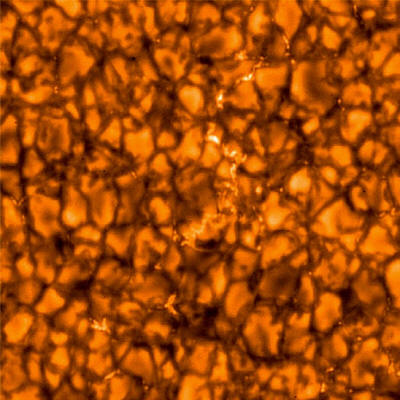|

by Stephen Smith
July 9, 2012
from
Thunderbolts Website

Surface granulation on the Sun is said to reveal convection zones.
Credit: Hinode JAXA/NASA/PPARC
It is commonly believed that there is an electromagnetic dynamo
inside the Sun.
That dynamo has long been thought to be
powered by two forces:
The “stretching and winding” of
magnetic fields due to the Sun’s differential rotation, or
change in rotation rate, caused by differences in latitude, and
the “twisting” of those fields because of rotational effects on
structures rising up from deep in the Sun’s interior.
The former
is called “the omega effect” and the latter is called “the alpha
effect”.
Until recently, those two forces were
thought to be what powers the Sun’s magnetic field.
Those movements
through the Sun’s substance, as well as thermal convection due to
the hypothetical radiation generated at the core, are required to be
above a certain power threshold or the theory cannot be sustained.
According to
a recent press release, researchers from New York
University, Princeton University, the Max Planck Institute, and NASA
have determined that the convective plasma flows in the Sun are 100
times too slow for the aforementioned phenomena to be generated.
Shravan Hanasoge of Princeton University said:
“These convective motions are
currently believed to prop up large-scale circulations in the
outer third of the Sun that generate magnetic fields. However,
our results suggest that convective motions in the Sun are
nearly 100 times smaller than these current theoretical
expectations… leaving us with no compelling theory to explain
its generation of magnetic fields…”
Again, as recently explained in a
previous report, what is wrong is not the observations.
In the electric model of stars, the Sun is a positively charged
electrode in a circuit, while the negatively charged electrode is
located far beyond the planetary orbits.
The “virtual cathode” is known as the
heliopause.
The electric model sees sunspots, solar flares, coronal heating, and
especially the Sun’s magnetic field, as fluctuations in the amount
of charge flowing into it. That electric current arrives in the form
of plasma filaments that are gigantic in scale.
They are extremely diffuse, but are so
large that they carry tremendous amounts of electricity. Those
Birkeland current filaments supply more or less power to the
electric circuit powering the Sun.
Stars shine because electricity flows through each galaxy.
As has
been written in these pages many times, stars can be thought of as
giant spheres of slow-motion lightning. It is this simple hypothesis
that best matches observational evidence. Any fusion takes place on
the surface of
an electric star like the Sun and not “deep in its
core.”
Electricity flowing through the solar plasma creates the Sun’s
highly dynamic magnetic field, so no convective regions, transition
zones, or alpha and omega effects are required.
|

